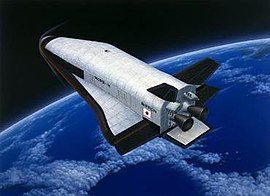HOPE-X

HOPE-X (Provided by JAXA)
|
|
| Country of origin | Japan |
|---|---|
| Size | |
| Height | 15.2 m (50 ft) |
| Diameter | 9.7 m (32 ft) (wing span) |
| Mass | 14 t (31,000 lb) |
| Stages | launched on H-IIA |
| Launch history | |
| Status | Project cancelled |
HOPE was a Japanese experimental spaceplane project designed by a partnership between NASDA and NAL (both now part of JAXA), started in the 1980s. It was positioned for most of its lifetime as one of the main Japanese contributions to the International Space Station, the other being the Japanese Experiment Module. The project was eventually cancelled in 2003, by which point test flights of a sub-scale testbed had flown successfully.
The original HOPE project called for the building of a sub-scale orbital prototype known as HOPE-X, for H-2 Orbiting Plane, Experimental. This would be used for flight testing and systems validation, before moving onto the larger HOPE, which used many of the same parts and general design in a 4-man 22-metric-ton (49,000 lb) design. As the name implies, both would be launched on Japan's new H-2 launcher, the full-scale HOPE requiring substantial upgrades in performance. At the time, Japan was an up-and-coming industrial powerhouse, and their space program was moving from success to success. There was little doubt, and a little trepidation, that HOPE would be successful.
As part of the overall Japanese space program, testing for technologies that would be used on HOPE and other projects was well advanced. In February 1994 the first test flight of the new H-2 launcher was used to also launch the experimental OREX ballistic re-entry vehicle, which tested various communications systems, heating profiles and heat shielding components. Another project, Hyflex, followed in February 1996. Hyflex was intended to test the carbon-carbon heat shielding tiles that were intended to be used on HOPE, as well as having the same body shaping in order to gather data on hypersonic lifting. Hyflex was successful, but sank in the Pacific after splashdown before it could be recovered.
...
Wikipedia
